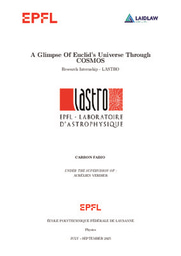A Glimpse Of Euclid's Universe Through COSMOS
A huge thanks to the Laidlaw foundation and its representatives at EPFL for making this internship possible in the first place. I am also extremely grateful to LASTRO for their warm welcome and trust for this project. I'm looking forward to seeing what comes next !
Here is a quick summary of my work for those who are interested :
"Our universe is yet full of secrets, hidden within distant galaxies, waiting for us to unravel them. One might say, all the answers lie right before our eyes; we just have to seize them. But how can we know where to look?
To tackle this, astrophysicists rely on vast surveys that map millions of galaxies across cosmic times. At the heart of this mission is the Euclid satellite, launched in 2023 by the European Space Agency. However, with its first public data release not expected until October 2026, we sought a way to perform early analyses ahead of time.
In this work, we explore the possibility of simulating Euclid’s observations using existing data from a rich collection of space- and ground-based measurements: the COSMOS survey. We propose a method to ensure a clean, high-quality and reliable catalogue, determining which objects would realistically be detected by Euclid. Using this simulated dataset, we identify a specific type of galaxy known as Emission Line Galaxies (ELGs), that appear brighter in some colours than in others. To detect them, we use “colour-colour diagrams”, which basically highlight these brightness patterns. Because they are easy to find and spread across the sky, ELGs are excellent tracers of the cosmic web, hence their importance.
This study is crucial because it provides a ready-to-use dataset to support preliminary analyses ahead of Euclid’s first public data release. We produced a robust Euclid-like catalogue and a new method to ensure reliable results. Moreover, once Euclid data become available, comparisons between results will allow us to verify the consistency of our method and lay the foundation for new exciting scientific opportunities. We also provide a final sample of approximately 15’000 objects assumed to be ELGs, a valuable resource ready to fuel future discoveries."


Please sign in
If you are a registered user on Laidlaw Scholars Network, please sign in